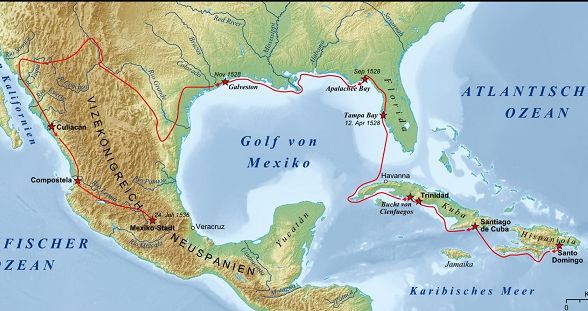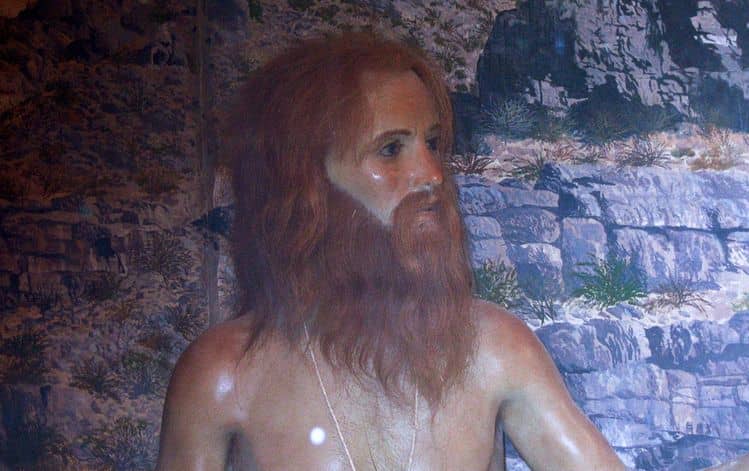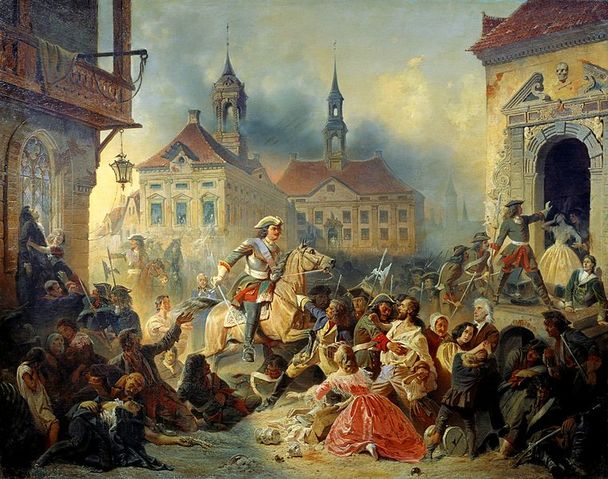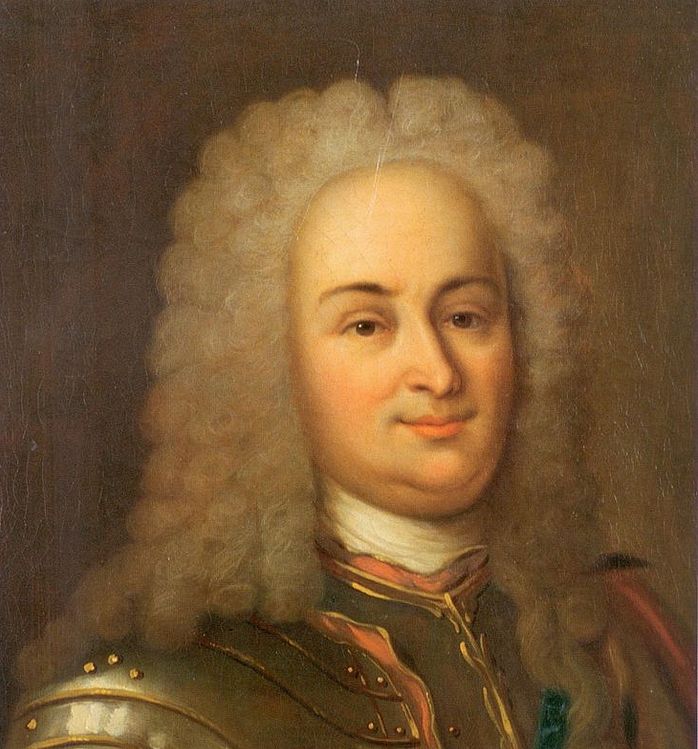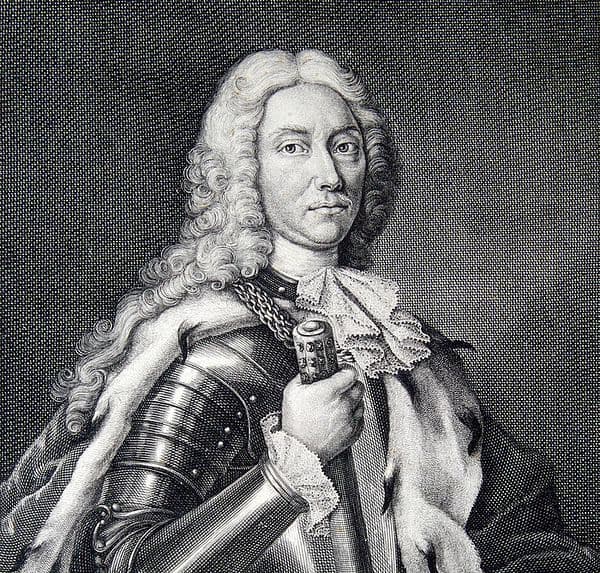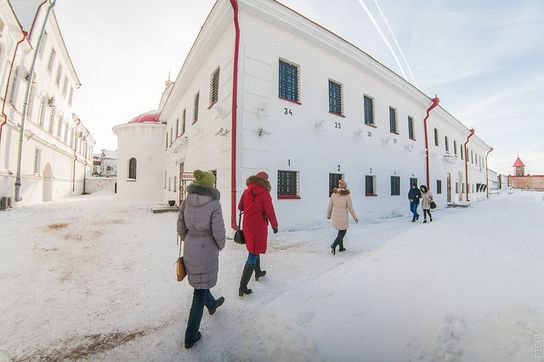“White” slavery was abolished in 1904 (at least officially).
But up until then, a person talking a walk in southern Poland could be kidnapped by a raid of Mongols. And someone sailing the Mediterranean could be abducted by Barbary pirates. Those captives ended up as white slaves in Asia and Africa.
Millions suffered such a fate in the last 500 years. Yet, as with most slaves, their stories are not known to us. Except for the accounts of a few who regained their freedom and were able to talk about their ordeals. Some even wrote them down.
Here are 7+ European aristocrats that ended up enslaved in recent centuries:
1. Alvar Nunez Cabeza de Vaca
The Spanish nobleman was born around 1490. His misadventures began when Spain’s king sent him in an expedition to colonize Florida, in the New World.

Alvar Nunez Cabeza de Vaca was named the expedition’s second in command.
Five ships with 600 men on board sailed towards the Americas in 1527. But the enterprise was to suffer every misfortune imaginable, from hurricanes and shipwrecks to Native attacks, starvation, exposure, and disease.
From noble to slave
After two tumultuous years, Alvar shipwrecked once more – for the fleet had shipwrecked before. This time, he was stranded near Galveston, Texas. Of the 600 explorers, only 80 remained. And by the next spring, starvation and Native ambushes had further decimated the group to 15.
Alvar survived, but the Europeans were now impossibly outnumbered. And the aristocrat was enslaved by a Native tribe, the Coahuiltecans.
In his memories (aptly called “Shipwrecks”), he related his captors beat him constantly and forced him to do menial work. To receive more food and better treatment, he pretended to be a healer. The strategy worked, and his status improved somewhat.
The escape
After four years, he reunited with the only three surviving members of the expedition. Among them was Alonso del Castillo, a fellow nobleman. The Spaniards had been held by neighboring tribes without knowing it.
The Natives kept all the Spaniards apart from one another, so it was difficult for them to plan an escape. Their captors discovered and foiled their escapes several times.
One night, in 1534, the Europeans finally managed the escape. They were now free, but their ordeal was not over. They walked for months through Texas, New Mexico, and perhaps Arizona (scholars have proposed different routes based on Alvar’s writings and archaeological data).
Along the way they worked, traded, ‘healed’, and were of general service to different tribes in exchange for protection and food. Finally, in 1536, they found a party of Spaniards in northern Mexico that took them back to civilization.
The shipwrecked explorer returned to Europe but did not stay long. Nunez Cabeza de Vaca led other expeditions to the Americas.
And later on, he was a governor in Mexico, Paraguay, and Argentina.
2. Jean Parisot de Valette

Jean de Valette had the most promising beginnings. He was born in 1494 in the Chateau de Labro, in southern France. His old and noble family appears in the Annuaire de la Noblesse de France, a publication that traces all the nobility of the country. His cousins were dukes. And his ancestors held high office and were close to the kings. They accompanied the monarchs to the Crusades. And Jean, a highly educated polyglot, was to follow in their footsteps, especially when it came to battling Islam.
Face to face with the Barbary pirates
During those times, Christians and Muslims were constantly fighting over the dominion of the Mediterranean. And 20-year-old Jean joined the Knights of Malta, a zealous Christian military order.
The Order governed the island of Malta and Tripoli. And from there, they launched attacks on -and repelled attacks by- the Barbary Pirates. These Muslim corsairs were allied with the Ottoman Empire.
By 1537, Jean was the governor of Tripoli. But abuse of power landed him in prison for four months.
Then, during a naval battle (1541), he was captured by the Order’s enemies: the fearsome Barbary pirates. These pirates captured Christian ships mid-voyage and enslaved crew and passengers. They also raided European coastal towns and enslaved their inhabitants. Several times they ventured out of the Mediterranean and pillaged villages in Britain, Ireland, and even in distant Iceland. According to some scholars, in 300 hundred years the Barbary pirates enslaved 1,000,000 Europeans, give or take.
The galleys and redemption

Marie-Lan Nguyen/CCBY2.5)
And just like that, Valette the aristocrat became a slave. At the time, many thought the worst possible fate for a slave was the galleys. For life in the galleys was brutal. Aside from having to row, the slaves were chained to the ships, whipped all day, and given only black bread to eat. Slave galleys had short lives. Valette ended up in the galleys.
Fortunately for him, members of his religious order were able to ransom him a year later.
In 1554, Valette became Captain General of the Order’s Galleys and, in 1557, Grand Master of the Order, which was a powerful position.
His greatest feat was to defend the island of Malta from a siege by the Ottomans in 1565.
The event has come down in European history as the Great Siege for its ferocity and because the stakes were high. If the Muslim forces won Malta, they would have an ideal base from where to launch the invasion of Europe.
The siege lasted four months, and Valette emerged as the victor. So the capital of Malta, Valetta, was named after him.
See also: Modern pirates: the hot spots were piracy thrives.
3. Lovisa von Burghausen
Lovisa’s parents were nobles from Narva, Swedish Estonia. In 1704, when Lovisa was a child, her city was attacked by the Russians. Her father was in charge of defending the city, but it fell. And Russian soldiers plundered the city. One of them took seven-year-old Lovisa as booty.
Later on, another Russian soldier decided that the pretty girl would make the perfect gift for his general. So he wrestled Lovisa from her previous owner and sent her, as a gift, to Russian Prince Anikita Repnin.
In the royal household, Lovisa had both friends and enemies. The prince’s mother went out of her way to protect her, while the prince’s wife, Pracovia, abused her at every chance.
Pracovia finally rid herself of the girl during a visit from Prince Dimitrie Cantemir of Moldovia. Dimitrie and his family were visiting the Repnins in Moscow. So Pracovia gave them Lovisa as a parting gift.
In the new court, the baker’s wife poisoned Lovisa, so the enslaved aristocrat escaped. But she did not make it very far.
A tailor suspected she was a runaway slave and reported her to the police. The Swede was arrested and taken back to Dimitrie’s palace.
A turn for the worse
Lovisa’s already bad luck took a turn for the worse. Her masters did not take kindly to her escape. Now they put her in chains, so she could hardly walk. And Lovisa was demoted to washing clothes in freezing water and weather.
The prince’s daughters, Ekaterina and Maria, took pity on her. At night, they would bribe a guard and sneak her into their rooms so the Swede could sleep. Their kindness saved the slave girl from freezing to death during the harsh Romanian winter.
One day, Prince Dimitrie traveled to Saint Petersburg. And he left Captain Iwanof in charge of his household. Iwanof’s wife decided to sell Lovisa and two other Scandinavian girls.
In the slave market, she traded Lovisa for damask, a fan, and some money.
Lovisa’s new owner was a merchant that took her to Tobolsk, in Siberia. The merchant beat her regularly and overworked her.
Reunion
The silver lining is that Tobolsk was full of Swedish prisoners of war. The Swedes befriended the girl. And they asked around and found out that her parents were alive. They, too, were prisoners, although they lived in another Russian city, Solikamsk.
Lovisa had been a slave for over a decade when her new friends helped her escape.
After more ordeals and close calls, she met Anna von Knorring, a Swedish noble. Anna, passing Lovisa as her niece, took her to Solikamsk by train. The von Burghausen family reunited in 1718.
Three years later, when the Great Northern War ended, the Russian government released the Swedish prisoners. So Lovisa’s family was able to return to Sweden.
Lovisa von Burghausen’s account of her years as a slave is kept in the National Archives, in Sweden.
4. Devereux Spratt

Devereux Spratt belonged to the landed gentry. In Ireland, he owned the estates of Torbey and Ballyberg, near Mitchelstown; and estates in Wexford and Cork. The Bishop of Rochester was his relative. None of this, though, was going to protect him from some grim years.
In the hands of pirates
Devereux was visiting his grandfather in Ireland. While there, the Oxford University graduate decided to become a Protestant priest.
He was still in the country when the Irish rebellion of 1641 exploded. The rebellion was aimed at Protestants. So Devereux boarded a vessel to escape to safer territory: England. But as soon as the ship sailed, it was captured by Algerian pirates looking for European slaves. Crew and passengers were put in chains.
In his autobiography, Devereux writes: “This thing [was] so grievous that I began to question Providence and accused Him of injustice.”
The reverend had an idea of what was going to be his fate, for it was hardly unheard of. Just between 1609 and 1616 Barbary corsairs captured at least 466 British vessels. And the British weren’t even their usual victims, that dubious honor fell on Spanish, French, and Italian ships and villages. It was highly profitable to sell Europeans in the slave markets of the Barbary states of Northern Africa (Algeria, Tunisia, Morocco).
The enslaved aristocrat was sold to a private citizen in Algeria who allowed him unusual freedom. When the reverend saw the misery of the other Christian slaves, he rediscovered his purpose and began preaching to them. But then his master sold him, which again dampened his spirits.
After years in captivity, Devereux was ransomed and freed. But he chose to remain in Algeria preaching to the white slaves to give them hope.
Two years later, though, all free Christians were ordered to leave the country. So Devereux went back to England and Ireland.
5. Vasilii Polozov
Vasilii was born to the lesser nobility of Russia in the 17th century.
At the time, Crimean Tatars habitually raided the south of Russia and Poland and abducted people. In their ‘best’ year, 1676, they enslaved about 400,000 souls in that region. Slavery fueled the economy of the Crimean Khanate.
Now, most of the captives were usually unfortunate farmers, but with those numbers, they were bound to trap a noble or two along the way. Like they trapped Vasilii. (A hundred years earlier, Russian Tsar Ivan IV had fully acknowledged in a speech that the Tartars held many of his aristocrats, both males and females, captive. Many European countries had a sum set aside to ransom their high-ranking citizens enslaved in Africa and Asia. In that particular speech, Ivan was trying to convince the Church that they should foot the bill for the ransoms, instead of the State.)
Sometimes, the Tartars would alert the Russian authorities of their catch, to receive a ransom. But others, they kept the slaves or sold them at the markets.
According to scholar Eizo Matsuki, Vasilii remained enslaved in the Khanate for two years. Then, he was given as a gift to the sultan of the Ottoman Empire.
For twenty years he served the sultan until he angered him with his refusal to become a Muslim. The infidel was sent to the galleys, a place all too common for Russian slaves. For in that same 17th century a traveling Croatian friar, J. Krizhanich, was shocked to find that Ottoman vessels were almost exclusively manned by involuntary Russian rowers.
Vasilii must have been a strong man, for he survived nine years in the galleys. When the ship went down, everyone drowned, except the enslaved aristocrat and a friend that made it to the shore. He had been a slave for about 31 years.
Back in Russia, in around 1678, he wrote to Tsar Fedor III narrating his misfortunes and asking him for a position.
6. Brigitta Scherzenfeldt

Brigitta’s life was far from easy. She was born in June 1684, in Skane, Sweden, to parents from the high class, some even say from the nobility.
At fifteen, she married Mats Bernow. And when Mats was deployed to Poland to fight in the Great Northern War, newlywed Brigitta made the unfortunate choice to tag along. After a series of misadventures, she found herself among the 20,000 Swedish prisoners of war taken by the Russians at the Battle of Narva.
The captives began a 145 km (90 mi) walk to Moscow and upon arrival, they were engaged in hard labor.
In 1712, Brigitta, who by now was twice a widow, was sent to Siberia along with her third husband. More misadventures followed, her husband was killed, and she was enslaved by the enemies of Russia: the Kalmucks of the Dzungar Khanate.
The Kalmucks stripped Brigitta of her clothes, chained her, gave her hard work, and fed her only raw meat. Eventually, a Kalmuck tried to rape her. According to her own account, Brigitta fought back furiously and bit the man.
News of the brawl reached the khan, the leader of the Kalmucks, who summoned both participants for an explanation. Brigitta told Khan Tsewang Rabtan that in her land men did not force themselves on women. The khan admired her response, gave her clothes, and sent her to serve his daughter.
Weaving, fourth husband, and return home
Her situation improved, as she now weaved textiles and was the confidant of the princess.
Years went by, and she met another Swedish captive: John Gustav Renat. Renat’s lot was better than Brigitta’s. He had made himself useful as a military advisor and had earned the respect of the khan.
Eventually, Renat was freed, and at his request, so was Brigitta. In 1733, the married couple was back in Sweden.
Brigitta had been away for 35 years. For 17 of those years, she had been a slave.
Her memoir is kept at the Royal Danish Academy of Sciences, in Stockholm. And Renat’s maps of Asia are kept at the Uppsala University Library.
7. Portuguese nobles

Young King Sebastian I of Portugal had been on the throne for most of his life: since he was three. He was raised by priests. And he became a zealous Christian whose life ambition was to wage a holy war on Islamic Morocco.
At 24, he was ready for the enterprise. He recruited soldiers and deeply indebted Portugal with foreign powers to raise money for the campaign. Then he sailed towards Africa accompanied by the Portuguese nobles.
On August 4, 1578, in Ksar el Kebir, Morocco, Sebastian faced the troops of Sultan Abd Al-Malik I. Historians describe the battle as a mismanaged disaster on Sebastian’s part. Both the sultan and the king died -although some thought Sebastian was alive and had been taken prisoner.
Morocco won the day: 8,000 Portuguese soldiers were dead and 15,000, captured. Only 100 men of the army made it back to Europe. The entire male aristocracy of Portugal had been wiped out. They were either dead or enslaved.
Consternation spread through Portugal. In a letter to the Abbot de la Vera, it is written: “In this city [Lisbon, the capital of Portugal], that I find has turned into Troy.”
Religious orders raised money for the orphans. And emissaries sailed to Morocco to ransom the prisoners. But the Moroccans were holding a grudge, and most captives were never freed.
The letter continues: “the king was accompanied by princes and soldiers, and those are the men that are now in captivity, serving the Moors (…), and so deprived of nobility.”
Portugal, bankrupt, without nobles or an heir to the throne, was invaded by Spain and annexed to its territories.
More Articles
